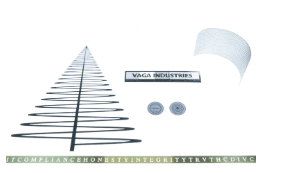
Home > Photo Etching > Photo Etching History
Photo Chemical Machining History
Vaga Industries specializes in photo chemical machining. Since 1966, we have been an industry leader in this specialized manufacturing process, and our decades of experience and highly skilled staff enable us to provide high quality, high precision thin metal parts for all applications.
Request a quote on photo chemical machining, or contact us to learn more.
What is Photo Chemical Machining?
Also known as photo etching or chemical etching, among other names, photo chemical machining is a subtractive machining process that uses carefully formulated, precisely controlled corrosive chemicals and photoresist masking to create two dimensional, thin gauge metal parts.
Photo etching is a cost-effective alternative to other manufacturing methods, and can take the place of stamping, punching, laser cutting, waterjet cutting, and EDM (electrical discharge machining) processes. Photo chemical machining does not create burrs or sharp edges, eliminating the need for secondary finishing. The process also maintains tight dimensional tolerances, even for highly intricate parts. Chemical etching is ideal for both mass production and prototyping.
A Brief History of Photo Chemical Machining
In its earliest and most basic form, photo etching utilized organic lactic acid and citric acid to corrode lead to create the pigment ceruse, circa 400 BCE. More effective chemical ething methods were developed in the first century CE, when alkaline etchants were first used.
During the Renaissance, the process was further refined, and photo etching chemicals-a mixture of salt, vinegar, and charcoal-were used to add decorative details to plate armor and other metal objects. By the 16th century, photo chemical machining was being used throughout Europe, as new advances made it a viable medium for visual arts.
It was not until the 17th century that chemical ething was put to use for industrial applications, when scales and other measuring instruments were etched with measurement markings. Use of the process expanded greatly and rapidly from that point.
True photo chemical machining was first achieved in the late 18th century, when it was combined with photographic processes to produce images on metal plates. In the 19th century, the discovery of hydrofluoric acid expanded the possibilities of chemical etching to include glass and other, nonmetallic materials.
Photo etching was commonly used to create printing plates for newspapers. The time-sensitive nature of breaking news and the daily commitments of printing a new edition each day gives some idea of just how fast and versatile the photo etching process can be.
More effective photoresist films (see below) and more powerful acids developed in the 20th century allowed for the chemical etching of stronger metals. In the 1960s, photo chemical machining was a key tool in the development of the printed circuit boards that led to modern computers.
The Photo Chemical Machining Experts
At Vaga Industries, chemical etching is a multi-step process that begins with the customer’s part design.
- Using a CAD program and the customer’s design file, blueprint, or drawing, the part shape is printed onto optically clear, dimensionally-stable film, called tooling or artwork.
- The tooling is then applied to a sheet of metal or alloy material.
- Tooling is exposed on the metal sheet using a UV light that hardens the area on the sheet that will be the “part.” The unhardened portion of the photo resist is then washed away.
- The metal sheet is sprayed with a chemical etchant. Heated and pressurized to flow evenly across both sides of the plate, the etchant reacts with the unprotected sections of the metal, dissolving it completely and relatively quickly.
- The photo resist artwork is then removed from the remaining material—the actual part being manufactured.
- Parts are cleaned, dried, and inspected using our strict quality control processes. They are then prepared for packaging and shipment.
By carefully nesting part shapes on the metal sheet, photo chemical machining can create multiple parts at once. The number will vary greatly depending on the size of the parts and the size of the etchant tank.
Photo Chemical Machining with Vaga Industries
Vaga Industries uses photo etching to produce simple and complex parts in thicknesses from 0.0002” to 0.062”. We work with a range of metals and alloys, including stainless steel, aluminum, and titanium. We provide personal, hands-on customer service, and pride ourselves on delivering parts that meet or exceed customer expectations.
Every part and component we manufacture is completely custom, based on the customer’s designs. Patterns for photoresist tooling are retained in our database for later use, which helps future orders go faster and cost less. All customer designs remain confidential.
Request a quote on photo chemical machining for your project, or contact Vaga Industries to learn more.




